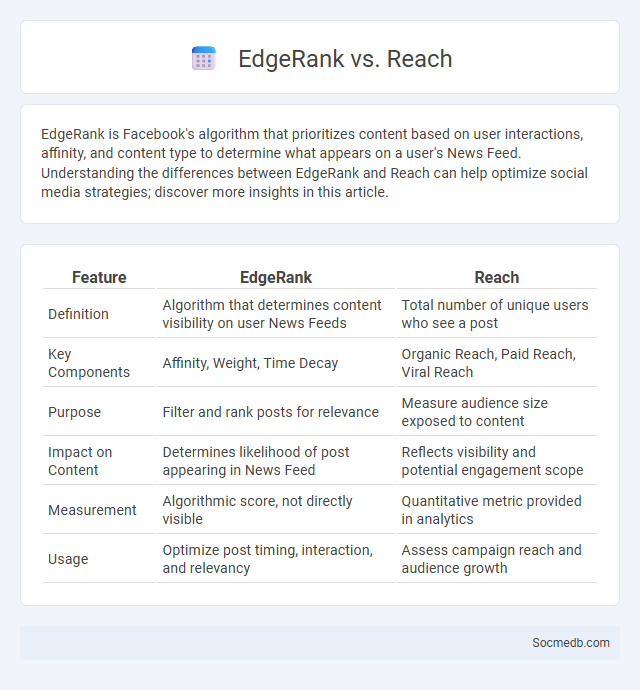
Photo illustration: EdgeRank vs Reach
EdgeRank is Facebook's algorithm that prioritizes content based on user interactions, affinity, and content type to determine what appears on a user's News Feed. Understanding the differences between EdgeRank and Reach can help optimize social media strategies; discover more insights in this article.
Table of Comparison
| Feature | EdgeRank | Reach |
|---|---|---|
| Definition | Algorithm that determines content visibility on user News Feeds | Total number of unique users who see a post |
| Key Components | Affinity, Weight, Time Decay | Organic Reach, Paid Reach, Viral Reach |
| Purpose | Filter and rank posts for relevance | Measure audience size exposed to content |
| Impact on Content | Determines likelihood of post appearing in News Feed | Reflects visibility and potential engagement scope |
| Measurement | Algorithmic score, not directly visible | Quantitative metric provided in analytics |
| Usage | Optimize post timing, interaction, and relevancy | Assess campaign reach and audience growth |
Understanding EdgeRank: Facebook’s Original Algorithm
EdgeRank, Facebook's original algorithm, determines the visibility of posts in users' News Feeds by analyzing three key factors: affinity, weight, and time decay. Affinity measures the relationship between the user and content creator, weight assigns value to different types of interactions such as likes, comments, and shares, while time decay prioritizes newer posts to keep feeds relevant. Mastering EdgeRank helps marketers optimize content engagement and increase organic reach on Facebook.
The Evolution of EdgeRank Over Time
EdgeRank, the original algorithm used by Facebook to prioritize content in users' News Feeds, has evolved significantly since its inception in 2011, moving from a simple formula based on affinity, weight, and time decay to a complex machine learning-driven system. Your engagement with posts now impacts visibility through personalized signals that account for interaction frequency, content type, and recency, making it crucial to create highly relevant and engaging content. Understanding this evolution helps optimize your social media strategy to improve reach and engagement on platforms influenced by Facebook's algorithmic changes.
What is Reach on Facebook?
Reach on Facebook refers to the total number of unique users who have seen a specific post, advertisement, or page content within a given timeframe. It measures the potential audience size exposed to your message, distinguishing it from impressions, which count multiple views by the same user. Understanding Facebook Reach is crucial for optimizing content strategy and maximizing engagement across organic and paid campaigns.
EdgeRank vs Reach: Key Differences
EdgeRank is Facebook's algorithm that determines which posts appear in users' News Feeds based on affinity, weight, and time decay, whereas Reach measures the total number of unique users who see a post. EdgeRank prioritizes content relevance by analyzing user interactions such as likes, comments, and shares to enhance engagement, while Reach simply quantifies exposure regardless of interaction. Understanding the distinct roles of EdgeRank and Reach helps marketers optimize social media strategies for visibility and audience engagement.
How EdgeRank Impacts Organic Reach
EdgeRank is a Facebook algorithm that determines the visibility of your posts in users' news feeds by evaluating factors such as affinity, weight, and time decay. Higher affinity scores, which reflect the relationship between you and your audience, significantly boost the organic reach of your content. Optimizing post engagement and timing can enhance your EdgeRank score, thereby increasing the likelihood that your social media updates are seen without paid promotion.
Factors Influencing Facebook Reach
Facebook reach is primarily influenced by the relevance and quality of your content, as the algorithm prioritizes posts that generate meaningful interactions such as comments, shares, and reactions. Posting frequency, timing, and the use of engaging multimedia elements like images or videos also play crucial roles in amplifying your organic reach. Understanding your audience's preferences through insights and tailoring your posts accordingly can significantly enhance your Facebook reach and overall engagement.
Is EdgeRank Still Relevant Today?
EdgeRank, Facebook's original algorithm, has evolved into a more complex system prioritizing content relevance, user interactions, and timeliness to enhance user experience. While the core principles of EdgeRank--affinity, weight, and time decay--remain foundational, the current algorithm incorporates machine learning and real-time data analysis to deliver personalized feeds. You can leverage this understanding by creating engaging, timely content that resonates with your audience to maintain visibility on social media platforms.
Comparing EdgeRank to Modern Facebook Algorithms
EdgeRank, Facebook's original algorithm, prioritized content based on affinity, weight, and decay to rank posts in user feeds, while modern Facebook algorithms utilize machine learning to analyze user behavior, preferences, and engagement patterns in real-time. Current algorithms incorporate deep learning models that consider factors like video watch time, click-through rates, and reaction types to optimize content visibility and personalized experiences. The shift from EdgeRank to sophisticated AI-driven algorithms reflects Facebook's aim to increase user interaction by delivering highly relevant and timely content.
Strategies to Improve Reach Despite Algorithm Changes
To improve social media reach despite algorithm changes, prioritize creating engaging, high-quality content that encourages user interaction such as comments, shares, and likes. Leverage data analytics tools to identify peak posting times and audience preferences, aligning content scheduling accordingly. Incorporate diverse media formats like videos, stories, and reels to maximize visibility across platforms like Instagram, Facebook, and TikTok.
EdgeRank vs Reach: What Marketers Need to Know
EdgeRank, Facebook's algorithm, prioritizes content relevance based on user interactions, affinity, weight, and time decay, impacting how your posts appear in followers' feeds. Reach measures the total number of unique users who see your content, highlighting visibility rather than engagement quality. Marketers must balance optimizing EdgeRank factors to enhance meaningful interactions while maximizing reach to grow brand awareness on social media platforms.
 socmedb.com
socmedb.com